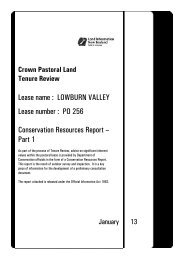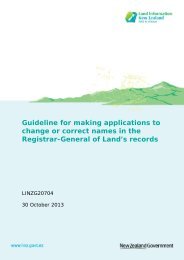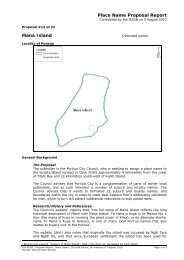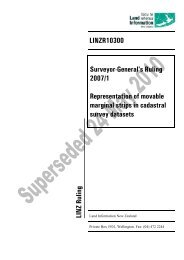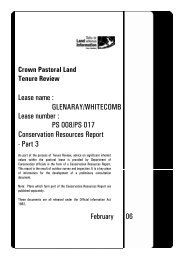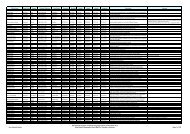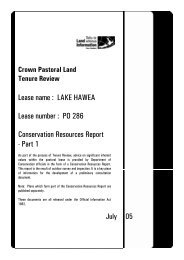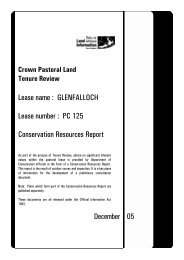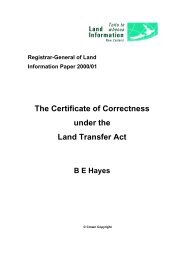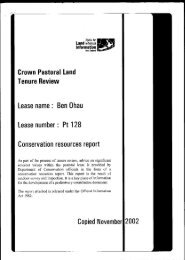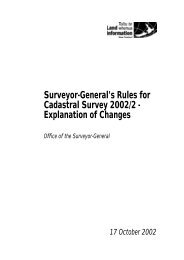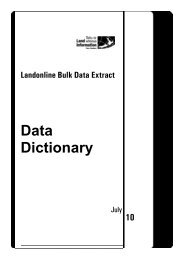Middle Hill Pastoral Lease - Land Information New Zealand
Middle Hill Pastoral Lease - Land Information New Zealand
Middle Hill Pastoral Lease - Land Information New Zealand
You also want an ePaper? Increase the reach of your titles
YUMPU automatically turns print PDFs into web optimized ePapers that Google loves.
“RELEASED UNDER THE OFFICIAL INFORMATION ACT”<br />
across the upper tributaries of Miller Stream in the northwest of the property. Smaller faults<br />
occur in the centre of the property and others bound the limestone outcrops.<br />
2.3 CLIMATE<br />
<strong>Middle</strong> <strong>Hill</strong> <strong>Pastoral</strong> <strong>Lease</strong> lies in an area characterized by very warm summer temperatures<br />
and frequent strong northwest winds, and moderate winter temperatures with occasional<br />
cool southerly winds. Annual rainfall is between 1000 and 1500 mm, with maximum<br />
precipitation during winter (Tomlinson, 1976). Snow lies for short periods on higher<br />
altitude parts of the property during winter months. The property lies in an area that has<br />
moderate solar radiation, high vapour pressure deficits and low annual water deficits<br />
(Leathwick et al, 2003).<br />
2.4 VEGETATION<br />
2.4.1 Ecological Context<br />
The original vegetation of the upland and hilly parts of the <strong>Middle</strong> <strong>Hill</strong> area was probably a<br />
diverse mix of black beech-mountain beech forest, beech-podocarp forest and podocarphardwood<br />
forest. At lower altitudes, relatively extensive areas of podocarp forest, podocarphardwood<br />
forest and lowland/coastal hardwood forest were present. Recently disturbed sites<br />
such as river beds and terraces would have supported kanuka forest or woodland, or open<br />
stonefield and herbfield communities. Steeper rocky country would have supported a sparse<br />
rockland plant community similar to that which is present today.<br />
In their analysis of the Level II <strong>Land</strong> Environments on the property Leathwick et al (2003)<br />
propose that <strong>Land</strong> Environment E1, covering almost 90% of the property, originally<br />
supported beech forest and podocarp-hardwood forest. <strong>Land</strong> Environment B8, covering<br />
lower slopes and terraces (c. 4% of the property), is described as supporting podocarphardwood<br />
forest. <strong>Land</strong> Environment J3, covering the main terraces at the eastern edge of<br />
the property beside the Clarence River (c. 4% of the property), is described as supporting<br />
kanuka-dominated woodland or hardwood forest. <strong>Land</strong> Environment P1, on the slopes of<br />
the Seaward Kaikoura Range at the western edge of the property (c. 2% of the property), is<br />
described as originally supporting mountain beech forest (Leathwick et al, 2003). The<br />
extent to which woody vegetation prevailed in the area prior to human settlement would<br />
have been influenced by natural erosion events and possibly the occurrence of natural fires.<br />
Analysis of the extent to which the <strong>Land</strong> Environments of the property are represented<br />
within existing protected natural areas indicates that approximately 19% of <strong>Land</strong><br />
Environment E1, 2.4% of <strong>Land</strong> Environment B8, 2% of <strong>Land</strong> Environment J3 and 49% of<br />
<strong>Land</strong> Environment P1 are protected (Department of Conservation, unpublished data, 2004).<br />
However these data should be interpreted with caution, as the predicted extent and suggested<br />
vegetation types for each <strong>Land</strong> Environment have been extrapolated from limited field data.<br />
CHCCO-70334 - <strong>Middle</strong> <strong>Hill</strong> CRR<br />
20-5-2005<br />
9



